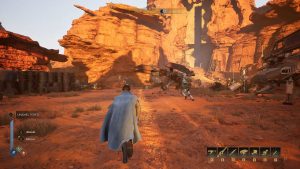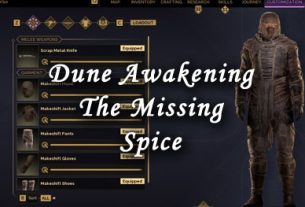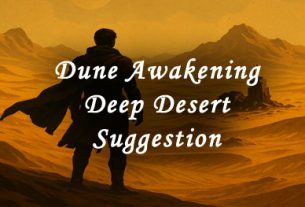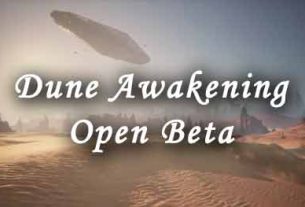Creating a Thriving Community in Dune: Awakening
Dune: Awakening has the potential to reshape the multiplayer survival genre by challenging the Pareto distribution, a phenomenon where a small number of dominant games capture the majority of the player base. Instead of following this pattern, Dune: Awakening aims to foster an evolving, community-driven experience that keeps players engaged over the long term.
With its Landsraad system, Deep Desert mechanics, and competitive crafting economy, the game creates a dynamic ecosystem where player actions drive change. By ensuring no two weeks feel the same, Dune: Awakening offers both casual and hardcore players a fresh, ever-evolving challenge.
The Landsraad System: A Political Endgame
The Landsraad, a central governing body in the Dune universe, is the heart of the game’s political endgame. This system drives competition, strategy, and long-term player engagement.

How It Works:
- Faction-Based Competition: Players align with noble houses such as Atreides, Harkonnen, or a third balancing force (dev may have 3rd faction but not 100% confirmed yet).
- Weekly Influence Battles: Players earn votes for their faction by completing tasks such as:
- Controlling Deep Desert territories
- Harvesting and delivering Spice
- Mapping and submitting hidden locations in the Deep Desert
- Server-Wide Rule Changes: The faction with the most votes enforces a rule that affects the entire server for the next week, such as:
- Reduced crafting costs for members
- Altered PvP rules (e.g., “Right of Salvage” looting in the Deep Desert)
- Faction-wide buffs or economic advantages
This evolving meta-game prevents stagnation and ensures ongoing political maneuvering and power shifts.
The Role of the Third Faction (Speculation)
A third faction could act as a balancing force, preventing one house from dominating too long. This faction might be:
- Imperial Agents (Sardaukar) – Enforcing stability and punishing overpowered factions.
- Spacing Guild Interference – Imposing restrictions on economic monopolies.
- Fremen Insurgence – A neutral but powerful force that intervenes when outside forces disrupt Arrakis’ ecosystem.
This dynamic prevents a stagnant meta, encouraging strategic alliances and political tension.
The Deep Desert: Ever-Changing Survival and Exploration
Dynamic, Weekly Resets
The Deep Desert is an evolving PvP-enabled region where players compete for resources, uncover lost relics, and battle against the elements. Unlike static open-world areas, the Deep Desert resets and restructures weekly, ensuring:
- No permanent structures – Avoiding territory hoarding.
- New resource placements – Ensuring fresh competition.
- Emergent player encounters – Encouraging alliances and betrayals.
Spice Wars and Sandstorms
The Deep Desert isn’t just barren wasteland—it’s the heart of Dune’s economy. To survive, players must navigate:
- Shifting Spice Fields – Deposits change weekly, and competition is fierce.
- Sandstorms – Sudden, unpredictable storms that wipe out weak structures and force players to adapt.
- Shai-Hulud (Sandworms) – The ultimate threat, devouring careless players who misuse technology.
These mechanics ensure that no two weeks are the same, making endgame survival a constant challenge.
Imperial Testing Stations: PvPvE Endgame Content
Scattered across Arrakis, Imperial Testing Stations are vault-like structures containing the remnants of the Imperium’s scientific experiments. These stations offer high-stakes PvPvE gameplay, blending intense combat, exploration, and crafting opportunities.

Key Features:
- Locations: Found in PvE areas (no PvP) and the PvP-enabled Deep Desert.
- Loot Rules:
- PvE Areas: Shared loot system, mainly containing regular schematics. While unique or rare blueprints may not be found here, this is not 100% confirmed.
- PvP Deep Desert: First come, first served loot system. This area has a higher likelihood of containing unique schematics, making it a hotspot for competition.
- Unique Schematics: The crafting system includes both regular and unique schematics. High-level schematics often require Imperial Permits, reinforcing the Imperium’s control over advanced technology.
- Limited Use: Unique schematics are consumed upon crafting, necessitating multiple copies for sustained production.
- Location-Specific Loot: These schematics are found in specific locations, such as ecology labs within Testing Stations.
- Time-Limited Availability: Some ecology labs may contain rare items, like the lazgun, but only for a limited time. After an event cycle, the location may vanish, reappearing only after months.
- Market Control: Players who obtain multiple copies of a unique schematic can corner the market, controlling the availability of high-demand gear.
- Competition: The limited nature of these schematics fosters intense player conflict over access to these valuable blueprints.
- Example – Emperor’s Wings: This early-game suspensor schematic is found in Testing Station #2, encouraging new players to engage with this system early on.
By integrating these mechanics, the game promotes exploration, economic warfare, and high-stakes PvPvE encounters.
Player-Driven Cartography and Economy
Map Trading: The Merchant Guilds of Arrakis
Unlike traditional games where maps are static, Dune: Awakening introduces cartography as a dynamic economy.
- Players explore, document, and sell Deep Desert maps, revealing hidden paths, resource-rich zones, and safe travel routes.
- Guilds and merchants can hoard or share information, creating a thriving black market for navigation data.
- Factions might spread misinformation, leading rivals into sandworm-infested areas or barren wastelands.
This system mirrors Frank Herbert’s themes of knowledge as power, reinforcing the importance of intelligence gathering in survival and dominance.
Shaping the Future of Survival Games
Many survival games struggle with retention due to the Pareto distribution, where a small percentage of games dominate. Dune: Awakening can break this pattern by:
- Evolving Gameplay Loops – Weekly-changing Landsraad rulings and Deep Desert resets prevent stagnation.
- Faction Balancing Mechanics – The third faction prevents server dominance.
- Player-Driven Economies – Maps, Spice, and political alliances ensure constant engagement.
- Endgame Conflict & PvPvE Integration – Dune’s brutal universe rewards strategy over grinding.
By embracing these mechanics, Dune: Awakening has the potential to redefine the survival genre, fostering a community that thrives on politics, survival, and ever-changing landscapes.
The Future of Arrakis is in Your Hands
Dune: Awakening is more than just another survival game—it’s a social experiment set in the harshest sci-fi universe ever created. With a focus on political intrigue, resource scarcity, and factional warfare, the game has the chance to redefine what endgame means in a survival game.
Whether you choose to manipulate the Landsraad, dominate the Spice trade, or control the Deep Desert’s hidden vaults, your decisions will shape Arrakis.
Will you bend the knee to power? Or will you break the cycle and reshape the future of Dune?


